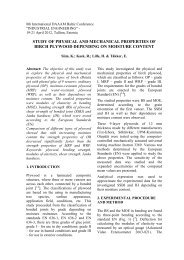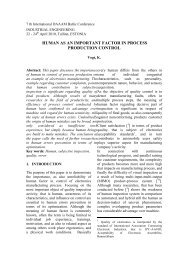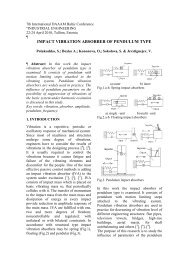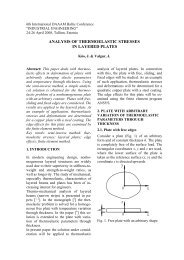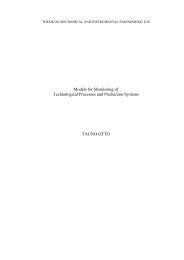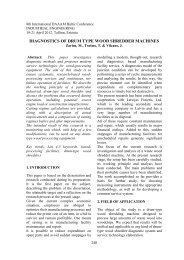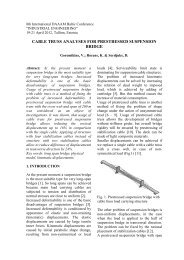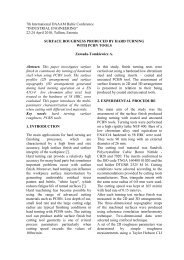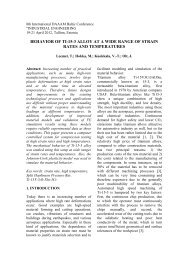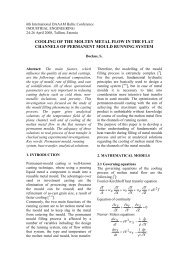Camera Gimbal Control System for Unmanned Platforms
Camera Gimbal Control System for Unmanned Platforms
Camera Gimbal Control System for Unmanned Platforms
You also want an ePaper? Increase the reach of your titles
YUMPU automatically turns print PDFs into web optimized ePapers that Google loves.
Fig. 3. Coordinate system 0 - ground, 1<br />
- air vehicle, 2 - camera gimbal<br />
of the plat<strong>for</strong>m. Tilt and roll axes (Y and<br />
X) rotational movement range depends<br />
higly on the pitch and roll movements of<br />
the aerial vehicle and also the task of the<br />
gimbal. For example if a gimbal <strong>for</strong> a<br />
photocamera had a roll axis movement<br />
range of ±90 degrees and an additional 10<br />
degrees of stabilization overlay, it could<br />
easily be used to take Portrait and<br />
Landscape pictures during the same flight<br />
without the need to mechanically<br />
reposition the camera.<br />
An important point was to keep in mind<br />
that the system must have the ability to be<br />
implemented in mechanisms of very<br />
different size and purpose. No matter if it is<br />
a 1, 2 or 3 axis mechanism, miniature,<br />
medium or large sized, <strong>for</strong> stabilizing a<br />
video- or photocamera or other sensorics<br />
like spectrometers – the same core system<br />
can be used and reconfigured with ease.<br />
All things considered, the most suitable<br />
flying plat<strong>for</strong>m <strong>for</strong> a first prototype was a<br />
remotely piloted helicopter as it can hover<br />
and move very slowly and thus makes an<br />
ideal solution to develop the camera<br />
gimbal system and tune its parameters.<br />
Hereby a 3 axis mechanism <strong>for</strong> a Canon<br />
DSLR camera was decided to be built as<br />
the prototype mechanism.<br />
The gimbal should actively compensate the<br />
rotational movements of the helicopter it is<br />
mounted on. Two of the main aspects in<br />
all motion control systems with similar<br />
tasks are position feedback and position<br />
reference data. Feedback tells us where the<br />
mechanism is, reference tells us where the<br />
mechanism has to be. The resolution of the<br />
feedback device along with the update<br />
frequency and accuracy of the reference<br />
unit are essential figures if a smooth and<br />
precise system is conseptualized. The<br />
kinematics scheme, mechanical properties<br />
and quality of the components and<br />
assembly determine the final quality of the<br />
system.<br />
2.1 Kinematics scheme<br />
The 3 axes of the prototype system<br />
compensate all the angular movements of<br />
the hull it is attached to and the general<br />
principle of the axes arrangement assure it<br />
is able to avoid the gimbal lock state during<br />
its normal operation. The configuration -<br />
pan over tilt over roll (Fig. 3) - allows up<br />
to 90 degrees of roll or pitch movement by<br />
the aircraft be<strong>for</strong>e a gimbal lock occurs,<br />
which of course is highly unlike to ever<br />
happen.<br />
2.2 Rotational movement feedback<br />
A simple camera control mechanism<br />
(camera gimbal) has 2 degrees of freedom<br />
– pan and tilt, that are driven by actuators<br />
which, incase of manual control, do not<br />
necessarily need to have any sorts of<br />
feedback (e.g. security camera gimbal in a<br />
supermarket). Now if we want precise<br />
in<strong>for</strong>mation regarding the cameras<br />
rotational movement, we must have either<br />
analog or digital feedback units installed,<br />
that detect rotational movement of the<br />
gimbals axis. Analog rotational movement<br />
detectors are called potentiometers, they<br />
output voltage, digital ones are called<br />
Fig. 2. Kinematics scheme showing 3<br />
revolute joints



